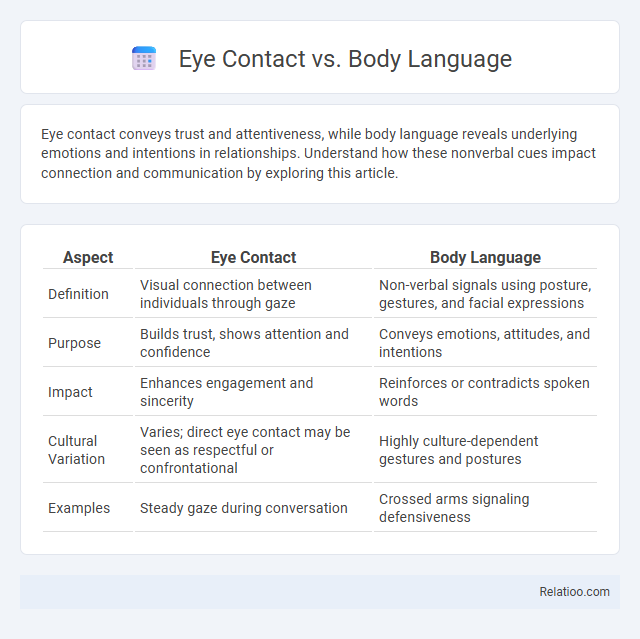Eye contact conveys trust and attentiveness, while body language reveals underlying emotions and intentions in relationships. Understand how these nonverbal cues impact connection and communication by exploring this article.
Table of Comparison
| Aspect | Eye Contact | Body Language |
|---|---|---|
| Definition | Visual connection between individuals through gaze | Non-verbal signals using posture, gestures, and facial expressions |
| Purpose | Builds trust, shows attention and confidence | Conveys emotions, attitudes, and intentions |
| Impact | Enhances engagement and sincerity | Reinforces or contradicts spoken words |
| Cultural Variation | Varies; direct eye contact may be seen as respectful or confrontational | Highly culture-dependent gestures and postures |
| Examples | Steady gaze during conversation | Crossed arms signaling defensiveness |
Understanding Eye Contact in Communication
Eye contact plays a crucial role in communication by conveying confidence, interest, and sincerity, while body language supports these messages by expressing emotions and attitudes through gestures and posture. Understanding eye contact helps your interactions become more engaging and trustworthy, as it signals attention and respect. Balancing eye contact with appropriate body language creates a powerful nonverbal connection that enhances overall communication effectiveness.
The Role of Body Language in Nonverbal Cues
Body language plays a crucial role in nonverbal communication by conveying emotions and intentions beyond spoken words. Unlike eye contact, which primarily signals attention and engagement, body language includes gestures, posture, and facial expressions that provide context and depth to interpersonal interactions. Your awareness of these nonverbal cues enhances understanding and strengthens connection in both personal and professional settings.
Eye Contact: Impact on Trust and Connection
Eye contact plays a critical role in building trust and connection, as it signals attentiveness and sincerity more powerfully than body language alone. Your ability to maintain steady eye contact can foster deeper emotional bonds and enhance communication effectiveness by conveying confidence and openness. While body language complements these cues, eye contact remains the most direct nonverbal tool for establishing credibility and rapport in interpersonal interactions.
Body Language: Expressing Emotions Without Words
Body language serves as a powerful tool for expressing emotions without words, using gestures, posture, and facial expressions to convey feelings effectively. Unlike eye contact, which often signals attention and connection, body language provides a broader spectrum of emotional cues, such as confidence, openness, or discomfort. Understanding body language enhances communication by revealing true emotions beyond spoken language, facilitating deeper interpersonal understanding.
Cultural Differences in Eye Contact and Body Language
Cultural differences in eye contact and body language significantly impact communication effectiveness across societies. In some cultures, sustained eye contact signifies confidence and honesty, while in others, it may be perceived as disrespectful or confrontational, influencing how your intentions are interpreted. Understanding these variations helps you navigate social interactions respectfully, ensuring your nonverbal cues align with cultural expectations.
Situational Appropriateness: When to Use Eye Contact or Body Language
Situational appropriateness dictates the choice between eye contact and body language, as direct eye contact enhances trust and engagement in personal conversations or interviews, while body language conveys emotions and intentions more subtly in group or formal settings. In high-stress or cross-cultural interactions, limited eye contact paired with expressive body language prevents discomfort and misinterpretation. Understanding context, such as professional environments favoring moderated eye contact and open body posture, optimizes communication effectiveness and audience perception.
The Psychological Effects of Eye Contact vs Body Language
Eye contact profoundly impacts psychological connections by conveying trust, confidence, and emotional intensity, whereas body language often reveals subconscious feelings and attitudes through posture, gestures, and facial expressions. Your ability to maintain appropriate eye contact can enhance rapport and social bonding, while interpreting body language provides deeper insights into unspoken emotions and intentions. Combining both effectively improves communication by balancing overt social cues with subtle nonverbal signals, ultimately shaping interpersonal dynamics.
Combining Eye Contact and Body Language for Effective Communication
Combining eye contact and body language enhances your communication by conveying confidence, sincerity, and engagement. Eye contact establishes connection and trust, while body language such as posture and gestures reinforces your message non-verbally. Mastering the balance between these elements improves clarity, emotional resonance, and overall interpersonal effectiveness.
Common Misinterpretations in Eye Contact and Body Language
Common misinterpretations in eye contact often involve perceiving avoidance as dishonesty or lack of confidence, whereas cultural differences heavily influence these perceptions. Body language can be misconstrued when gestures, posture, or facial expressions convey unintended emotions like disinterest or aggression despite neutral intent. Understanding the nuances and context of both eye contact and body language is crucial to avoid inaccurate judgments in communication.
Improving Communication Skills: Mastering Eye Contact and Body Language
Mastering eye contact enhances trust and engagement by signaling attentiveness and confidence during conversations. Body language complements verbal communication through facial expressions, gestures, and posture, providing nonverbal cues that reinforce or contradict spoken words. Improving communication skills requires integrating consistent eye contact with positive body language to create a compelling and authentic interpersonal connection.

Infographic: Eye contact vs Body language
 relatioo.com
relatioo.com